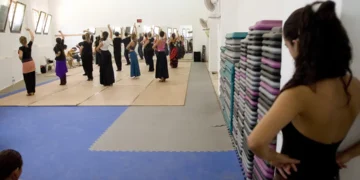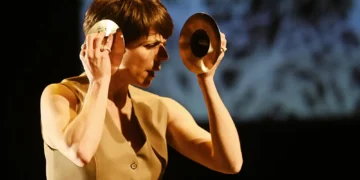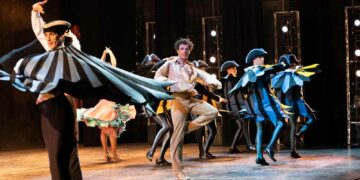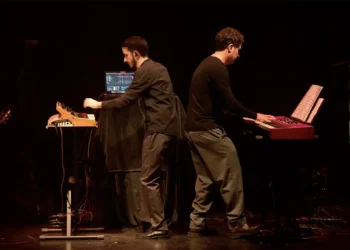|
XV FESTIVAL DE JEREZ |
|
Text: Estela Zatania LEONOR LEAL “¡ELE, ELE!” Dance: Leonor Leal, Juan Parra (special collaboration). Cante: Rocío Márquez, Juana la del Pipa (special collaboration). Guitar: Paco Iglesias. Percussion: Raúl Botella.
Nowadays in flamenco everyone wants to surprise, innovate, be noticed or that most desired of all things: to be classified as “fresh”. Flamenco is fashionable, and there’s a big expanding market for it despite the economic situation. But you see so many works, and all too often it seems the road to innovation is not very…innovative. Darkness is supposed to symbolize maturity, coldness stands in for sophistication and contemporary dance substitutes traditional flamenco effectively eliminating polkadots, compás, forms, even cante and other symbols of a past that some people find old-dated. The generational clash is permanent and there is hardly any dialogue. Except in the mind of Leonor Leal. This dancer comes with no apparent intellectual baggage, with an open attitude and ideas that are as original as they are straightforward. The pretext is innocent and deceptively obvious: put the most classic kind of flamenco on the same stage along with today’s most modern kind, observe both as objectively as possible, look for shared values and differences and celebrate all of it. Thus, we have the ethereal angelical voice of young Rocío Márquez, and that of Juana la del Pipa, the queen of roughhewn voices. We have Leonor with her short pixie haircut, dancing geometric choreographies, but there is also veteran dancer Juan Parra with all his classic dignity and gravity dancing caracoles and alegrías with castanets, or wearing a rehearsal skirt to be Leonor’s maestro to whom she listens with the greatest attention. It’s an unforgettable moment when Parra dances tangos with Juana, and then Leonor also dances tangos to the celestial voice of Rocío. There are abundant and well-conceived moments of humor, most notably when the two veterans seem perplexed as they observe the ultra-modern dancing of Leal, arguing afterwards about its merits and finally arriving to the conclusion, in the voice of Juana, that it’s “marvellous!” The sweetness and luminosity of Leonor and Rocío, the dense darkness of Juan and Juana, who could ever have thought of putting them all together in the same show? Sometimes you don’t know the real brains behind the success of a work. Obviously you have to give a lot of credit to the interpreters, but it looks a lot like Francisco López, former director of the Festival de Jerez, who figures on the program as stage director and author of the original idea and libretto is the one we have to thank. COMPAÑÍA RUBÉN OLMO “TRANQUILO ALBOROTO” Dance and choreography: Rubén Olmo. Corps de ballet: Ana Morales, Patricia Guerrero, Rosana Romero, Sara Vázquez, Alejandro Rodríguez, Ángel Sánchez Farina, Eduardo Leal. Cante: Inma la Carbonera, Moi de Morón. Guitar: Óscar Lagos, Andrés Martínez. Flauta: José Manuel García Marchena. Cello: Nicasio Moreno. Percussion: Agustín Diassera. Bagpipes: Rubén Díaz. Marching band: Agrupación Musical San Juan de Jerez de la Frontera. Choreography “Falsa farruca”: Israel Galván.
The show called “Tranquilo Alboroto” had every possibility to be a success – a magnificent corps de ballet, good guitars and voices and the good taste and wisdom of Rubén Olmo who leads the group. And in fact they were successful, both in the Bienal and last night as well. If the elements are first-class, there might be a certain lack of coherence in the pacing of the work. What seems to start out with a contemporary experimental agenda, the absolute focus on Olmo and a mental landscape worthy of Di Chirico (it’s not every day you see Jesus Christ dancing as “Nazarene gypsy” to a marching band of 75 people), little by little turns into a standard flamenco group, the “Suite Flamenca”, when Olmo disappears from the stage for more than three quarters of an hour. In fact, the only complaint about this work is the uncontrolled diversity and an overload of group numbers, when the greatest impact comes from the individual dances. There’s material here for two whole shows. In “Las Manuelas”, the tribute to Manuela Vargas, that nearly forgotten goddess, Olmo is spectacular, and this is one of the highlights of the show, along with the “Falsa Farruca” choreographed by Israel Galván and showing the latter’s unmistakable personality. Generally speaking, “Tranquilo Alboroto” would have greater impact if some of the group numbers were culled, but there is no doubt this is an important work, carried out with genuine affection and intelligence, both of which can be traced back to Rubén Olmo.
At one o’clock in the morning, at the venerable flamenco club Los Cernícalos, Carmen Herrera, Antonio Fajardo Junquera and Juan Pedro Carabante put their talents on display for nightowl flamenco fans. |




 Wednesday, the sixth day of the Festival de Jerez, the first show was the work of young Jerez dancer, Leonor Leal, and it was a pleasant surprise.
Wednesday, the sixth day of the Festival de Jerez, the first show was the work of young Jerez dancer, Leonor Leal, and it was a pleasant surprise. At the Villamarta theather, and work that debuted in the last Bienal de Sevilla, and which has ripened nicely over the winter.
At the Villamarta theather, and work that debuted in the last Bienal de Sevilla, and which has ripened nicely over the winter.



















